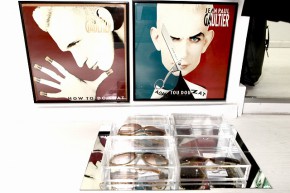
 It can be said that vintage clothes themselves are very popular in London and there are a great number of shops, but we don’t really have many opportunities which enable us to see and buy the rare ones made by legendary designers in particular.
It can be said that vintage clothes themselves are very popular in London and there are a great number of shops, but we don’t really have many opportunities which enable us to see and buy the rare ones made by legendary designers in particular.
HOUSE OF LIZA, which was opened last year in 199 Kingsland Road, is a boutique selling expertly curated pieces of pret-a-porter from designers who were the most experimental and pioneering in previous decades, such as Jean Charles de Castelbajac, Jean Paul Gaultier, Stephen Sprouse, Thierry Mugler and Kansai Yamamoto.
Having individual story and history in those times, every single garment in the shop is still shining today after a few decades and can be seen not only as a beautiful art piece or inspiring historical reference but also as a super cool street wear.
Goncalo Velosa, who is the owner of the shop and has really fallen in love with those vintage pret-a-porter especially the ones from 80s and 90s, answered our interview with the passion for his vintage collections.
-Can you let us know the concept of the shop?
The shop stocks unique vintage pieces by designers who were at the cutting edge of fashion when the pieces were created. Today’s consumers prefer their products to have history and evoke a sense of the past. House of Liza focus on clothes that defined the vanguard of their period. The collection is based on my own personal archive that I have been collecting for a few years now. The archive reflects my passion for fashion, the designers that have inspired and surprised me. These tend to by from mainly the 80s and 90s, which is when I was growing up. It was a very exciting period, with a buoyant economy and a sense of rebellious experimentation.
-Can you let us know your personal background before opening this shop? Why did you get interested in fashion, especially how did you come to find the passion for designers’ vintage pieces, and why did you decide to open this shop?
Back home in Portugal I studied furniture design and dabbled in costume design. During my teenager years, in the 80’s, I lived between Oporto and Paris and I got involved in the whole clubbing and music scene, and of course fashion was intrinsically entwined with both. I was part of a generation that developed a revolutionary taste for experimentation, and for sure I have used fashion as a way to explore and define my personality. Since those days I have been collecting fashion, which in turn lead to open a couple of guerilla stores in Portugal. After moving to London and studying fashion design at London College of Fashion I realised that I do prefer to work with other designers work so I decided to go back to vintage retail.
-What does the name of the shop ‘House of Liza’ mean? Why did you come to choose the name?
The be very honest with you, the name came by accident. When I decided to open the shop I wanted to play with the idea of “Fashion House” or as in the French tradition, Maison. I also wanted the name to reflect my own personal inspiration and preferences in art and music. I always had a fascination with Andy Warhol and the music that came out of New York during the late 70s and 80s. And as it happened I was staring at the wall wondering what would be the best name for a shop when I realized I was staring at an album cover designed by Warhol for Liza Minnelli. It just struck me, Liza Minnelli encapsulates the sort of glamour and bohemian decadence that is reflected in my collection and choice of location.
-The shop stocks considerable amount of rare vintage pieces of legendary designers, such as Jean-Charles de Castelbajac, Jean-Paul Gaultier, Thierry Mugler, Stephen Sprouse and Kansai Ymamoto. What are the essential elements or ideas when you handpick those pieces?
My first criteria is that I must fall in love with the piece first. But for me to really appreciate a piece it has to be unique and represent the epitome of a particular period, innovation or designer’s career. My collection can be said to be very niche – the designers, their unique approach in terms of materials, cut or style, even though vintage, are still today considered cutting-edge and experimental. For instance, most people still today don’t understand Rei Kawauko’s descontructed clothes or the exuberance and pop aesthetic of Jean-Charles de Caltelbajac. There is a strong bias towards the 80s and early 90s (although I have pieces dating back to the 60s), which again reflect my personal tastes and life. It was during this period that I got involved in the whole art, music, fashion and club scene. So those designers and their clothes bring back many happy and fun memories.
-What do you consider the significant differences between those designers’ vintage pieces and new contemporary designers’ ones? What are the definitive aspects that those vintage pieces have but new ones don’t?
The designers on my collection all made important contributions to change the course of fashion and people’s relation to it. I strongly believe that there is a continuation and evolution, if you like. It is impossible to understand today’s fashion without looking at the past. A lot of the designers on my collection paved the way for the work of some of the most conceptual contemporary designers.
-I think there would be many people who have personal collections of those rare early designers’ pieces, but there are not really many people who actually wear those pieces. Do you think those rare early designers’ pieces should be actually worn by people in streets, or they should be treated more like art pieces?
I definitely think the pieces should be worn. For me there’s nothing like seeing people on the street with a unique sense of style. Fashion has the power to convey so many messages. Look at Lady Gaga or Madonna for instance. Both their careers were built on a clever appropriation of cutting-edge fashion that is provocative, yet alluring. A lot of my clients and the creative people living in Shoreditch feel confident enough to buy and wear some of my most experimental pieces. But having said that I also think it is important to preserve and conserve some of the most influential pieces so that future generations can have first-hand access to better understand the evolution of fashion and craftsmanship.
-Do you know there is the huge market of vintage designers’ pieces in Japan, which includes from very young designers’ labels to more luxury brands? There are great number of secondhand brand shops and some auctions on the Internet are quite popular with Japanese people as places to buy and sell secondhand stuff. Some people say it is good as they can recycle their clothes, but others say the cycle is too fast and people are just obsessed with shopping, rather than enjoying fashion.
What do you think about the situation in Japan and those opinions?
The Japanese market is very unique and specific. While there is certainly some truth that Japanese people are consumerist, I also believe they are truly obsessed with fashion. Fashion in Japan is very important to convey not only your lifestyle and standing in life. Where as in Europe people consume fashion that reflects current trends and their own personal style, in Japan fashion, and in particular certain brands, are deployed to show your social standing, moral values and tribe affiliations. I am not saying that this doesn’t happen in the rest of the world, but in Japan is profound. For instance a few years ago, a magazine guest edited by the Maison Martin Margiela produced by the Antwerp fashion school dedicated the whole issue to extreme fashion victims in Japan. According to the magazine, only Japanese consumer get totally obsessed with a particular designer or brand, spending most of their wages buying the entire collection every season. One of the people featured in the magazine was so obsessed with his Martin Margiela clothes that he stopped eating at home so not to add any unpleasant odours to his clothes. He also stopped using eau de toilette as the chemicals used in them can alter fabrics and colours. His behaviour was so extreme that all his clothes were hanged, rather than folded, avoiding any exposure to direct sunlight. This phenomenon is unique to japan. Nowhere is the dedication to specific brands and designers so obsessive as in Japan. Their loyalty and engagement with a particular brand is far greater than in most countries.
 HOUSE OF LIZA
HOUSE OF LIZA
199 Kingsland Road, E2 8AN London, UK
Wed-Sat. 12:00-18:00
http://www.houseofliza.co.uk/
http://houseofliza.tumblr.com/
For a private view contact
gv@houseofliza.co.uk










